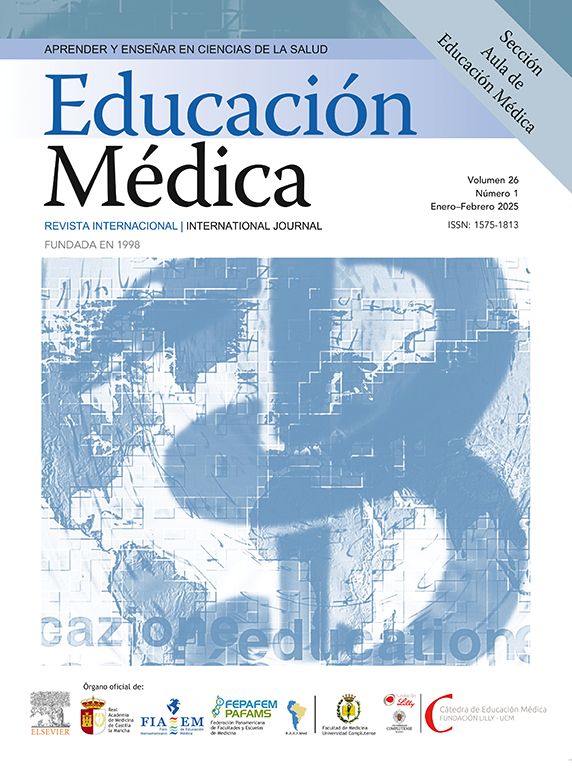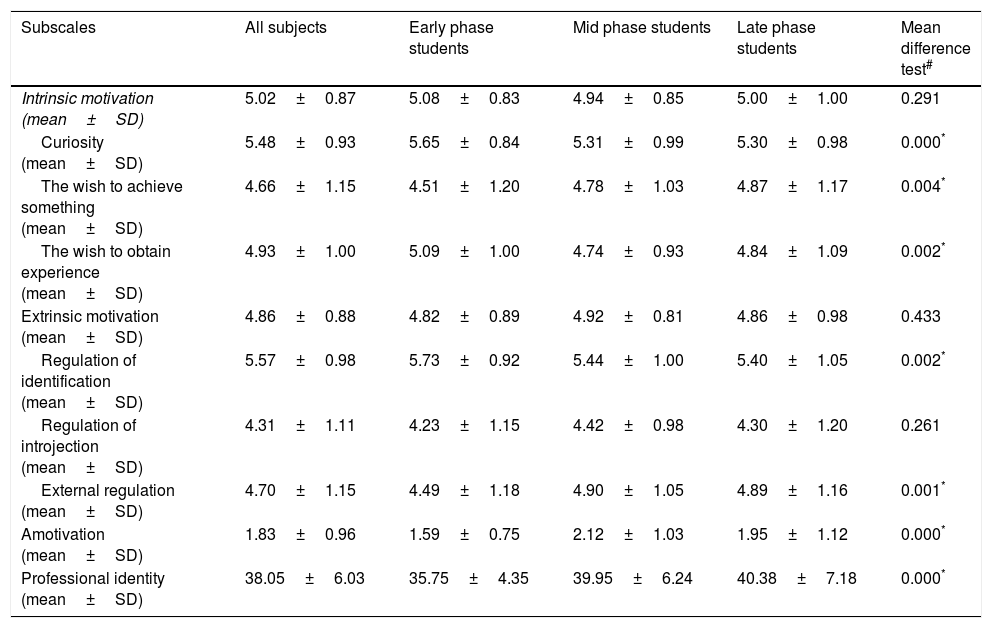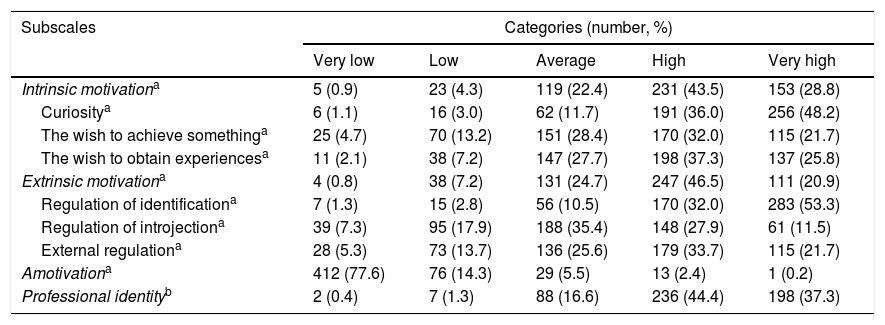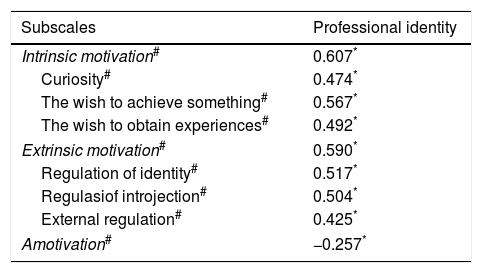Professionalism is a skills area that should be mastered by medical graduates. The period of formal education is essential for the formation of professionalism. The involvement of internal factors, such as academic motivation, and external factors, such as the learning environment, might play a role in the development and learning of professional identity.
AimTo determine the profiles of academic motivation and its relationship between student professional identity during their degree courses.
MethodsThis cross-sectional study included 531 medical students in the early, mid, and late phases of their courses in the Gadjah Mada University Faculty of Medicine. The Academic Motivation Scale of Vallerand was used to assess academic motivation, and the Professional Identity Scale of Adams to assess professional identity.
ResultsThe mean scores of academic motivation domains including intrinsic, extrinsic, and lack of motivation among medical students in the Gadjah Mada University Faculty of Medicine were 5.02±0.87, 4.86±0.88, and 1.83±0.96 (mean±standard deviation), respectively. No significant differences were found between the intrinsic and extrinsic motivation scores among students in the three phases of education, while the scores on lack of motivation among students in earlier phases were lower than students in the mid and late phases (P<0.000). The mean total score of professional identity was high and increased with the duration of training. Correlations were found in academic motivation, including internal, external, and lack of motivation, and professional identity (r=0.257–0.607, P<0.01). Intrinsic and extrinsic motivation correlated positively with professional identity, while lack of motivation negatively correlated with professional identity.
La profesionalidad es un área de las competencias que deben dominar los médicos graduados. El período de educación formal es esencial para la formación de la profesionalidad. La elaboración de factores internos, como la motivación académica, y de factores externos, como el ambiente de aprendizaje, podrían incidir en el desarrollo y formación de la identidad profesional.
ObjetivoDeterminar los perfiles y la correlación entre la motivación académica y la identidad profesional de los estudiantes durante el período educativo.
MétodosEste estudio fue de corte transversal, y en él participaron 531 estudiantes de medicina en distintas fases de sus estudios —principios, mediados y finales— de la Facultad de Medicina de la Universidad Gadjah Mada de Indonesia. Para la evaluación se utilizaron dos instrumentos: la escala de motivación académica de Vallerand para evaluar la motivación académica y la escala de identidad profesional de Adams para determinar la identidad profesional.
ResultadosLas puntuaciones medias de los dominios de la motivación académica incluyendo la intrínseca, extrínseca y amotivación entre los estudiantes de medicina fueron 5,02±0,87, 4,86±0,88 y 1,83±0,96 (media±desviación estándar), respectivamente. No hay diferencias significativas entre las puntuaciones de motivación intrínseca y extrínseca entre estudiantes en las tres fases de la educación, mientras que las puntuaciones de amotivación entre los estudiantes en las fases de principios eran más bajas que las de los estudiantes en las fases de mediados y finales (p<0,000). La puntuación media total de la identidad profesional fue alta y creciente junto con la duración de la educación. En esta investigación se encontraron correlaciones entre motivación académica —incluyendo la intrínseca, extrínseca y amotivación— e identidad profesional (r=0,257–0,607, p<0,01). La motivación intrínseca y extrínseca correlacionaban positivamente, mientras que la amotivación correlacionaba negativamente con la identidad profesional.
The current healthcare practice is faced with the demand to improve professionalism and the quality of service. Various challenges and threats to medical professionals compel doctors to recognize, understand, and properly apply their professional attributes.1,2 Professionalism is shown by the commitment to maintain and improve the quality of healthcare and to continually develop strategies to work according to professional standards.3,4
The process of medical education is basically a process of forming professional identity, including the development of and the learning about professionalism.5 During the period of formal education, the students adapt to the processes to enter the professional world, to understand themselves better, and to learn about the interactions among individuals within the profession and later to be ready to become a part of the profession.2 They develop professionally as they gradually obtain the ability to elaborate and reflect on the knowledge, skill, and experience they obtain during the educational period.6 The interaction of students and all parties within the institution, such as lecturers, students of the same profession, other health-related students, and other professions, as well as supporting staff, plays a significant part in forming the professional identity of medical students.7 Good synergy between internal individual factors and external factors leads to the development of a mature professional identity. As an external factor, the institution where students learn might play a role in encouraging the growth of professional attributes within the students or instead, slowly decrease their professional idealism.2,8
According to the social cognitive theory of learning, the environment forms the behavior, and all subsequent responses are mediated by the person's cognition.9,10 Individuals are continuously interacting with their environment. This learning process implies that observations, imitations and examples as well as the use of feedback, rewards, and disincentives/punishment might become significant aspects of students’ character development. In addition, internal factors such as self-efficacy, motivation, and the individuals’ ability to reflect also encourage their behavioral process of learning.11 A student's motivation has been recognized as a significant predictor for learning, academic success, determination, and continuity in a program.12
Theoretically, motivation has been proposed to correlate and to play an important role in encouraging the process of identity identification.13 A person's in-depth involvement and the existence of high targets on certain processes might imply the growth of self-identity and one's commitment to specific values. The correlation of academic motivation and professional identity in relation to external factors, however, has been little explored. Studies describing academic motivation and professional identity, as well as the manner in which the two variables might correlate, are therefore required, especially within the Faculty of Medicine Universitas Gadjah Mada. These studies should become a part of the exploration of the development of profesionalism among medical students as a predictor of success in the early, mid, and late phase/clerkship of their formal education.
MethodsThe current study employed a descriptive analytic method with a cross-sectional approach. Respondents of this research were medical students of the Faculty of Medicine Universitas Gadjah Mada, Yogyakarta, Indonesia. The research involved 531 students from three phases of education including 257 students of early phase, 171 students of mid phase, and 103 students of late phase/clerkship. Before completing the questionnaires, they were provided with and signed written informed consent forms. The Ethics Committee of Faculty of Medicine Universitas Gadjah Mada approved the research (Ref: KE/FK/741/EC).
The academic motivation in this research was measured using the questionnaire Academic Motivation Scale (AMS) developed by Vallerand et al.14,15 in French, that was later validated by Kusurkar et al.16 in English which consists of 28 items, and each item has seven Likert scale options of responses. Academic motivation is divided into seven subscales of three motivation types including intrinsic motivation (curiosity, the wish to achieve something, and the wish to feel/obtain), extrinsic motivation (regulation of identity, regulation of introjection, and external regulation), and amotivation. Concerning the professional identity (PI), it was measured by adapting a questionnaire from Adams et al.7 that consists of nine items, in which each item has five Likert scale options of responses (1=disagree strongly, 2=disagree, 3=neutral, 4=agree, 5=strongly agree).
The validation of the questionnaires was conducted before the commencement of the study. The steps of validation17 were as follows: (1) translation of the questionnaire from English to Indonesian, (2) a review of items of the questionnaires with three students and two consultants, (3) a preliminary study on 53 nursing students from the Faculty of Medicine Universitas Gadjah Mada, (4) testing the validity of items using Pearson's Product Moment correlation test, and (5) testing of instrument reliability using Cronbach's Alpha.
The determination of intervals and categorization (range of values) were calculated using the normal distribution approach.17 Five categories were defined: (1) very high (ideal mean+1.5 ideal standard deviation (SD)<score≤ideal maximum); (2) high (mean+0.5 SD ideal≤ideal mean+1.5 ideal SD); (3) moderate (ideal mean−0.5 ideal SD≤ideal mean+0.5 ideal SD); (4) low (ideal mean−1.5 ideal SD<score≤ideal mean–0.5 ideal SD); and (5) very low (ideal minimum≤score≤ideal mean−1.5 ideal SD) for each scale or total score of each questionnaire.
The AMS questionnaire demonstrated validity for all 28 items and seven subscales (values of the count of coefficient of correlation (r) was higher than r in the table, >0.279), and the same applied for all nine items in the PI questionnaire. In addition, the reliability test of both AMS and PI questionnaires also demonstrated the reliability of each item or scales in both questionnaires.
Data from the respondents were analyzed according to the distribution and characters of each data, and the research question. Data distribution was assessed statistically using the Shapiro−Wilk normality test. Mean differences were analyzed using mean difference test of one-way Anova that were continued by post hoc Least Significant Differences test or the Kruskall−Wallis differential test, followed by post hoc Mann−Whitney test. To evaluate the correlation between two numeric variables, the Pearson or Spearman correlation test was conducted. Data analysis was conducted using the statistical software Statistical Package for the Social Sciences (SPSS) IBM® version 21.
ResultsCharacteristics of respondentsThree different years of enrollment represented the three phases of the respondents’ education. Students of early phases were represented by first year students who had only been studying for two weeks in the Faculty of Medicine Universitas Gadjah Mada. The students of the mid phase were represented by third year students who had been in their education for about two years. Meanwhile, students of the late phase were represented by students who were on their clerkship and had been studying for four to five years. Characteristics of respondents of each group are presented in Table 1. No differences were found in terms of distribution of sexes and parents’ health-related occupational background within the three groups being compared (P values from χ2 test were P=0.771 and P=0.744, respectively).
Characteristics of subjects.
| Characteristics | Early phase students | Mid phase students | Late phase students |
|---|---|---|---|
| Number of subjects | 257 | 171 | 103 |
| Age (mean±standard deviation) | 18.14±0.93 | 20.02±0.64 | 22.88±0.93 |
| Gender (males, percentage) | 96 (37.6%) | 69 (40.4%) | 42 (41.17%) |
| Parents’ occupational background of health-related field (yes, percentage) | 73 (29.68%) | 55 (33.74%) | 32 (32.99%) |
The mean score of intrinsic motivation in medical students of the Faculty of Medicine Universitas Gadjah Mada were higher than the extrinsic motivation with no differences among three groups of students. However, there were some differences of means of subscales that supported intrinsic and extrinsic motivation between early-mid-and late phase of students (see Table 2). Amotivation was found within the categories of very low in all respondents. The mean of amotivation in early phase students was significantly lower than students in the mid and late phase of their study. There were dynamics of mean scores of academic motivations scale based on the educational phase. Table 3 is showed the distribution of categorization for academic motivation scores of the subjects.
Mean scores of academic motivation subscales and professional identity among different student groups.
| Subscales | All subjects | Early phase students | Mid phase students | Late phase students | Mean difference test# |
|---|---|---|---|---|---|
| Intrinsic motivation (mean±SD) | 5.02±0.87 | 5.08±0.83 | 4.94±0.85 | 5.00±1.00 | 0.291 |
| Curiosity (mean±SD) | 5.48±0.93 | 5.65±0.84 | 5.31±0.99 | 5.30±0.98 | 0.000* |
| The wish to achieve something (mean±SD) | 4.66±1.15 | 4.51±1.20 | 4.78±1.03 | 4.87±1.17 | 0.004* |
| The wish to obtain experience (mean±SD) | 4.93±1.00 | 5.09±1.00 | 4.74±0.93 | 4.84±1.09 | 0.002* |
| Extrinsic motivation (mean±SD) | 4.86±0.88 | 4.82±0.89 | 4.92±0.81 | 4.86±0.98 | 0.433 |
| Regulation of identification (mean±SD) | 5.57±0.98 | 5.73±0.92 | 5.44±1.00 | 5.40±1.05 | 0.002* |
| Regulation of introjection (mean±SD) | 4.31±1.11 | 4.23±1.15 | 4.42±0.98 | 4.30±1.20 | 0.261 |
| External regulation (mean±SD) | 4.70±1.15 | 4.49±1.18 | 4.90±1.05 | 4.89±1.16 | 0.001* |
| Amotivation (mean±SD) | 1.83±0.96 | 1.59±0.75 | 2.12±1.03 | 1.95±1.12 | 0.000* |
| Professional identity (mean±SD) | 38.05±6.03 | 35.75±4.35 | 39.95±6.24 | 40.38±7.18 | 0.000* |
Abbreviation: SD, standard deviation.
Distribution of frequency of categories or academic motivation subscales and professional identity.
| Subscales | Categories (number, %) | ||||
|---|---|---|---|---|---|
| Very low | Low | Average | High | Very high | |
| Intrinsic motivationa | 5 (0.9) | 23 (4.3) | 119 (22.4) | 231 (43.5) | 153 (28.8) |
| Curiositya | 6 (1.1) | 16 (3.0) | 62 (11.7) | 191 (36.0) | 256 (48.2) |
| The wish to achieve somethinga | 25 (4.7) | 70 (13.2) | 151 (28.4) | 170 (32.0) | 115 (21.7) |
| The wish to obtain experiencesa | 11 (2.1) | 38 (7.2) | 147 (27.7) | 198 (37.3) | 137 (25.8) |
| Extrinsic motivationa | 4 (0.8) | 38 (7.2) | 131 (24.7) | 247 (46.5) | 111 (20.9) |
| Regulation of identificationa | 7 (1.3) | 15 (2.8) | 56 (10.5) | 170 (32.0) | 283 (53.3) |
| Regulation of introjectiona | 39 (7.3) | 95 (17.9) | 188 (35.4) | 148 (27.9) | 61 (11.5) |
| External regulationa | 28 (5.3) | 73 (13.7) | 136 (25.6) | 179 (33.7) | 115 (21.7) |
| Amotivationa | 412 (77.6) | 76 (14.3) | 29 (5.5) | 13 (2.4) | 1 (0.2) |
| Professional identityb | 2 (0.4) | 7 (1.3) | 88 (16.6) | 236 (44.4) | 198 (37.3) |
Mean score of professional identity of all respondents was in the category of very high (score of >36). There was a difference between the mean professional identity scores between students in the early and late phase (see Table 2). The data distribution of professional identity in each student's group is tabulated in Table 3.
Correlation of academic motivation and professional identityStatistically significant correlation was obtained between academic motivation and professional identity (r=0.257–0.607, P<0.05, Table 4). The directions of correlation among subscales of amotivation and professional identity were negative or in opposite direction, with a weak correlation (r=−0.257). The highest correlation was between the intrinsic motivation and professional identity (r=0.607).
Correlations of academic motivation subscales and professional identity.
Each medical student has different motivation when choosing this study program as their desired field. It might be driven by personal wish or external factors such as prestige and enforcement from parents. In the context of learning and as a construct of psychology, motivation plays an important role in affecting the energy of the learner and his or her level of activity, directing the learner to certain goals, increasing initiatives and determination in certain activities, and it also affects the strategy of learning and the cognitive process of such effort.18,19
The self-determination theory of motivation20,21 that has been a basic part of the development of AMS14,15 differentiates motivations based on one's autonomy into amotivation, extrinsic motivation and intrinsic motivation, and these three types of motivation are considered within a continuum. The current study found that the mean scores of amotivation of helplessness in studying that represents the lowest motivation on the continuum were very low among the research subjects. This result was in concordance with the findings of high intrinsic motivation scores, and applied for all domains. The high academic motivation among students is an asset to achieve good academic achievement and a predictor for continuity of advancement of study, profession, or occupation.22,23 In addition, the mean scores for external motivation in this research were high. Along with the strong self-determination, external reinforcements provide encouragement to subjects’ choices. The mean score of identity regulation was higher than external regulation and regulation of introjection. This result demonstrated the tendency that despite the prominent drive from external factors, such as superior values held by the community, internal regulation and determination were pre-existent within the subjects.15
Motivation has a liquid nature. It's amenable to change and is affected by multiple factors.24 The stages or educational phases are found to be one of those factors.22 This study showed a dynamic of mean scores of motivations among students in early, middle, and late phases. Wilkesmann et al.25 in Germany showed no differences in intrinsic motivation and extrinsic motivation among new students (semester two) and students in late phase (semester eight). According to Stover et al.,26 external motivation and amotivation in students of senior high school in Argentina were higher than college students. This result was because junior high school education was a part of a compulsory education, however, being a student in a higher education was a choice. The senior high school students’ younger age and their dependence to parents might also play a role for such findings. A research by Burstein et al.27 on medical students showed that first-year students were more achievement-oriented than third-year students. The inconsistencies of these results were thought to be caused by other factors that also affect motivation but had not been properly controlled, such as age, sex, ethnicity, socioeconomic status, educational background, support from parents and teachers, including the capability for autonomy, individual competence and exposure to the desired professional field.22 The theory of self-determination is not hierarchical, however. Individuals need not to go through all styles of regulation. Past experiences allow individuals to adapt to new situations and within a short time could reach the level of being autonomous. Deci and Ryan21 also emphasized that individuals might not only have one style of regulation. People may have each motivation in certain degrees.
Professionalisms are defined as the quality and conduct that are characteristics of a profession or the characteristics of a professional.28 In medicine, professionalism is defined as the habit and the use of communication, knowledge, technical skills, clinical reasoning, emotions, values, and reflections in daily practice wisely for the interest of individuals and the public they serve.29 To become a professional, exposures and reflections on those particular experiences would be required by involving knowledge and technical skills that are continuous and long standing.2,30 From the perspective of learners (medical students), this transformation is a process of identity development in the form of knowing what doctors do and ways of being involved with other people within their profession.
This research demonstrated a step-wise development of professional identity from early phase, mid phase, and end phase/clerkship, as evidenced by the increased mean scores of professional identity that were translated as a student's point of view toward themselves of the characteristics of a field or profession that they have.31 There was a significant increase from the early phase to mid phase, but it was constant from the mid phase to the late phase. This pattern should serve as a feedback for the institution providing the education, curriculum and study room for students to better create the synergy in the development of professional identity. The study environment affects the development of professional identity through the simultaneous process of achievement of norms as a positive reinforcement and erosion of idealism as a negative reinforcement.2,6 During the period of formal education, the students are expected to identify alternatives offered by the profession, to elaborate experiences, and to finally be committed to the shared values and professional goals.32
The existence of correlations between academic motivation and professional identity provided the evidence of such synergy in this research. Academic motivation that shaped behavior determined the steps of achieving success, and has been demonstrated to play an important role in developing professional identity. Strong positive correlation between intrinsic motivation and professional identity implied that individuals who are intrinsically motivated are more likely to be involved in a more in-depth learning, showing increased strength in their performance, and have an increased creativity that engages in learning as a transformative experience, which plays a significant part in the growth of a strong professional identity.20,33
Competing interests and fundingThe authors have not received any funding or benefits from industry or elsewhere to conduct this study.












